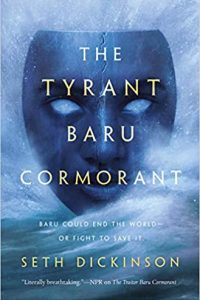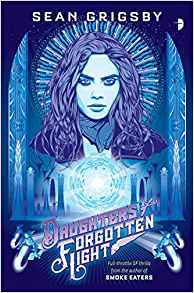Paul Di Filippo Reviews The Tropic of Eternity by Tom Toner
 The Tropic of Eternity, Tom Toner (Night Shade 978-1-59780-911-5, $26.00, 380pp, hc) August 2018.
The Tropic of Eternity, Tom Toner (Night Shade 978-1-59780-911-5, $26.00, 380pp, hc) August 2018.
Fans of Saga, that superlative postmodern-space-opera in graphic novel form, created by Brian K. Vaughan & Fiona Staples, had cause to mourn recently. Issue 54 brought the tragic death of a main character, and also the news that the series would go on indefinite hiatus. If I could offer any solace to these readers, it would be that awaiting them, as a highly palatable and satisfying stand-in, is Tom Toner’s Amaranthine Spectrum series, which flaunts a very similar vibe and many of the same allurements. Enigmatic doings that resolve only after long stretches of plot. Characters who are truly bizarre, yet easy to bond with. Weird technology. Chaos and mortal perils alternating with domesticity. Infinite odd venues. A toleration and enjoyment of narrative detours. A sense of titanic forces erupting into the quotidian lives of average people. The challenges, moral and physical, of fulfilling one’s destiny. The interplay of politics and culture. Multi-stranded narrative strategies. All these attractions are to be enjoyed in the works of both Toner and Vaughan & Staples.
When I reviewed the first volume in Toner’s trilogy, The Promise of the Child, for Locus Online, I trotted forth comparisons to the novels of A.A. Attanasio, Cordwainer Smith, Gene Wolfe, Roger Zelazny, M. John Harrison, and others. High company indeed. Those benchmarks still stand in books two and three, but as I get deeper into Toner, I am minded to link his name with three additional simpatico writers: T.J. Bass, whose cult classic Half Past Human featured some of the same biological craziness as the Toner books; David Zindell, whose Neverness cycle is lamentably overlooked these days; and John C. Wright, whose two far-future sequences – The Golden Oecumene and Count to the Eschaton – also conveyed the notion that any reasonably complex and advanced galactic empire would be much more odd and unnerving than, say, the familiarities of the Federation in Star Trek: The Original Series (and think what you will of Wright’s problematical extra-literary pronouncements, his achievements in these two sagas are indisputable).
Before diving into our discussion, newbies might like to know what the books are about. That request cannot be fully satisfied here. The densities of the backstory and current events are thick. Basically, in the year 14,647 the vast star empire dubbed the Firmament is failing, as factions battle for control of the Throne. (The elite Amaranthines of the Firmament are more-or-less immortal posthumans.) Another polity, the Prism Investiture, is more primitive yet vigorous, and is attempting to establish beachheads on many planets. The population of the Investiture are hundreds of upstart races descended from the old human stock, now warped and weird.
Central to the plotting is an entity named Aaron, who is a disembodied “machine soul,” thousands of years old, who now happens to be temporarily housed in the rotting revenant corpse of a dinosaur-like alien. He wants to rule the Firmament. Leading one anti-Aaron contingent is an Amaranthine named Maneker, whose lot becomes entangled with a resident of Old Earth, Lycaste, a sensitive and naive member of the race of demiurgic giants known as the Menius. Fold in scores of other significant characters and more alien environments than all the Dune books and Foundation books put together, and you begin to see the impossibility of synopsizing. Nonetheless, Toner helpfully includes a handy précis in volumes two and three that keeps affairs relatively straight, along with a Glossary of places, peoples and things. Even new readers should be able to get up to speed before plunging ahead.
Book Two of the Amaranthine Spectrum, The Weight of the World, features some of the “delaying of consequences” tactics found in many middle volumes. There’s a lot of traveling about as our heroes seek allies, avoid enemies, chase prizes, and marshal their forces for bigger things to come. But this is not to say that the novel is slack or uninventive or unexciting. The rigors that our various parties undergo are illustrative of their characters and the larger world. A major character, Perception, or Percy, another machine soul like Aaron, is introduced. And there are advances and setbacks in the schemes of all the contending factions.
Here’s a highly redacted and compressed sample of Toner’s unceasing display of wonders:
Gleaming jewels scattered the gentle light of the place like a Wiro’s fairy-tale dungeon, and among them other, more darkly indecipherable things lurked half-buried; machines and bejeweled Statuary Tombs, engine parts and suits of armour…. There lay the ship of the ancients: the Dilasaur vessel discovered in the rings of Saturn-Regis thousands upon thousands of years ago…. As he moved closer, he noticed that the out-thrust spindle of its nose was crumpled and shredded, and that great dents in its fuselage had been made by a huge and deadly impact… And here he was now, a Lacaille knight at the end of an epoch…. In the flicker of his helmet torch, he saw there was rodent shit everywhere.
This juxtaposition of the exotic and the scatalogical is typical of Toner’s balancing act, which grounds his wonders in the carnal realities and demands of daily living, much as Delany does.
If book two was slightly dilatory, book three, The Tropic of Eternity, pulls out all the stops, with enormous battles, surreal journeys, and resolutions to most of the character arcs. (Is it the true conclusion to the series? Well, it very gratifyingly ties up many of the threads, but leaves others dangling, so let’s call it the end of “Season One.”) It’s hard to nominate one thread that’s more important than the others, but if we had to pick, it would be the tale of Lycaste. After all, he was our entry to the series in book one, and his tale closes out book three with a truly touching, melancholy homecoming akin to the return of Odysseus. And Lycaste is probably the character who changes the most from start to finish, the others being rather fixed in their ways.
Aside from Lycaste’s tale, we also follow the mystical adventures of Sotiris and Corphuso in an alternate dimension that harks back to the surrealism of A Voyage to Arcturus. (“Corphuso…gazed down the colossal slope…. The place where the land levelled was almost lost to the murk, a pinkish country of meadows and glinting, sun-bright lines – distant roads, perhaps canals. He could see continent after continent, the path through the meadows marching ever on.”) We chase after the pitiful yet malign Billyup, a Gollum-like fellow who has kidnapped Arabis, a baby who happens to be heir to a small empire. We see what happens when a revolutionary named Cunctus, who rides into battle on a sea monster named Scallywag, undermines the old safeguards of the Firmament. (“One duke was missing his head and instead had been strung up by an arm.”) We follow a hapless ship’s crew through a stargate to another galaxy where the Snowflake-shaped Hedron Stars abide. And of course the super-science machinations of Aaron reach their destined end.
Toner has a knack for alternating his sections for maximum suspense and variation. His dialogue is precise, witty and revelatory. His neologisms and general nomenclature rivals that of Jack Vance. And his staging of action scenes, both small and large, is laudable. This third novel honors the accomplishments and promises of the first two, and serves as a fitting capstone to a unique creation.
Tempering the challenging abstruseness of Ada Palmer’s novels with the anything-goes action swerves of A.E. van Vogt and with the poetry of Le Guin, Tom Toner’s Amaranthine Spectrum delivers a new flavor of space opera that is bound to dazzle and delight.
This review and more like it in the November 2018 issue of Locus.
 While you are here, please take a moment to support Locus with a one-time or recurring donation. We rely on reader donations to keep the magazine and site going, and would like to keep the site paywall free, but WE NEED YOUR FINANCIAL SUPPORT to continue quality coverage of the science fiction and fantasy field.
While you are here, please take a moment to support Locus with a one-time or recurring donation. We rely on reader donations to keep the magazine and site going, and would like to keep the site paywall free, but WE NEED YOUR FINANCIAL SUPPORT to continue quality coverage of the science fiction and fantasy field.








FYI – some of us would like to find out what happens in Saga #54 by reading #54 itself, and not from reading a book review in Locus Online.
I was wondering if you have any opinion on whether the “ghosts” and “spirits” really fit in the genre of “science fiction”? Did you understand Corphuso’s theory, or can you give some sort of explanation that might fit in with even “super-science”, as you call it?